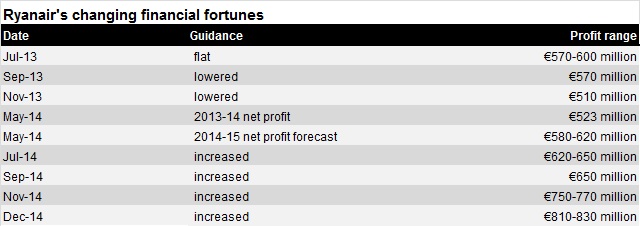If there was some scepticism when Michael O'Leary a year ago began taking tentative steps in repositioning Ryanair, a fourth profit upgrade of this financial year suggests that the budget airline many loved to hate is doing something right.
Much of the scepticism was around how serious the airline – synonymous with rigid booking restrictions and a no-nonsense approach to customer service – actually was about changing in its efforts to become more customer friendly, notably for business traffic.
There were initially tentative moves into peeling back some of the punitive restrictions around bookings. But this has turned into a wider-ranging push which has evolved to include allocated seating, Ryanair's first distribution through GDS channels, and moves into more mainstream airports.
"It's just following the market," says Peter Morris, chief economist at Flightglobal consultancy Ascend. "Before, they worked their way down the demand curve; in other words they worked out at what price they could get people to travel to places they didn't before. And they did a very effective job of doing that. And at the same time, through economies of scale, they drove down their costs, to offer even lower prices.
"But there is a limit to that, especially in a low-growth economy. Having, not exhausted exactly but reached a pause, they then looked at alternatives, and clearly the examples you could see from Easyjet are with the higher yield and a product more appropriately focused on the business market. The [Ryanair] model started off driving down the demand curve, and now it's moving up the demand curve."
This seems to have been a profitable move. Ryanair's financial fortunes before the strategic change were not exactly perilous compared with those of a large number of its European counterparts – a run of profits broken only by a one-off fuel hedging hit. But two profit warnings in a row last autumn sounded alarm bells, particularly for an airline with a track record of largely conservative guidance and profits historically higher than originally forecast.
But since the unveiling of these first steps, Ryanair's profit momentum has been on the up. After net profits fell 8% for 2013-14, to €523 million ($702 million), Ryanair has raised profit expectations for the current year four times. The top end of its new net profit range for 2014-15, at €830 million, is €250 million higher than the bottom of its original guidance.

That latest profit increase – which came in early December, just a month after the previous upward revision – was based on a strong first month of the winter season, which prompted the airline to lift full-year traffic expectations by a million to 90 million passengers. In particularly, Ryanair highlights the strong traffic and load-factor performance on several of the new routes aimed at attracting business travellers – including the return to UK domestic flights, from London Stansted to Glasgow and Edinburgh.
"There is a lot of momentum within the business right now. Ryanair is seeing a very positive response from the market as it returns to growth," says Oliver Sleath, European airlines analyst at Barclays. He points to the strong result of a 7% increase in load factor in November despite a 13% capacity boost in one of the toughest demand months of the year.
"I think it's evidence that all the changes they have put in place – the customer service improvements, network shift towards more primary airports – are having a real impact," he says. Alongside this, Sleath also credits the airline's new forward-bookings strategy which has helped it lift overall load factors by selling more seats further out.
"Certainly, the initial evidence that is coming back, in terms of passenger forecast and profitability forecast, seems to show for not doing very much – and the things they have done are really trivial on the scale of things – and yet it stimulated a certain amount of additional traffic," adds Morris. "Some of the actions have little or no cost attached to it, so why not do it?"
While Ryanair has taken steps, it remains focused on cost, and much of its network and operation is still based on leisure traffic, so the transition is still at a formative stage. "I think O'Leary summed it up well when he said there now seem to be very few markets in Europe which Ryanair can't enter and take share in," Sleath says. But he notes that there is still some way for the airline to go before its network and brand is established as a hybrid carrier, in the way EasyJet has done. "I think it will take a good five years to get there," he says.
But while crediting Ryanair's progress over the last year, Sleath adds that it is also possible that the demand environment might be more favourable than economic and competitive factors would suggest.
"What's interesting is, there has not been much negative impact on EasyJet. Its overlap with Ryanair is growing and the capacity environment is more competitive than it has been used to. But EasyJet is still guiding for flat revenue per seat," he says. "It feels to me the like the demand environment in the market is better than might be expected."
While Ryanair has taken on low-cost carriers in some markets – for example Vueling, alongside incumbent flag carriers at Brussels and Rome Fiumicino – it has not significantly taken on EasyJet. "Both have singly avoided, apart from one or two skirmishes, going head to head," says Morris. "But the question arises: if growth isn't occurring from other sources, will they be looking to move their tanks onto EasyJet's lawns, especially if they do something about recalibrating the product?"
Source: Cirium Dashboard



















